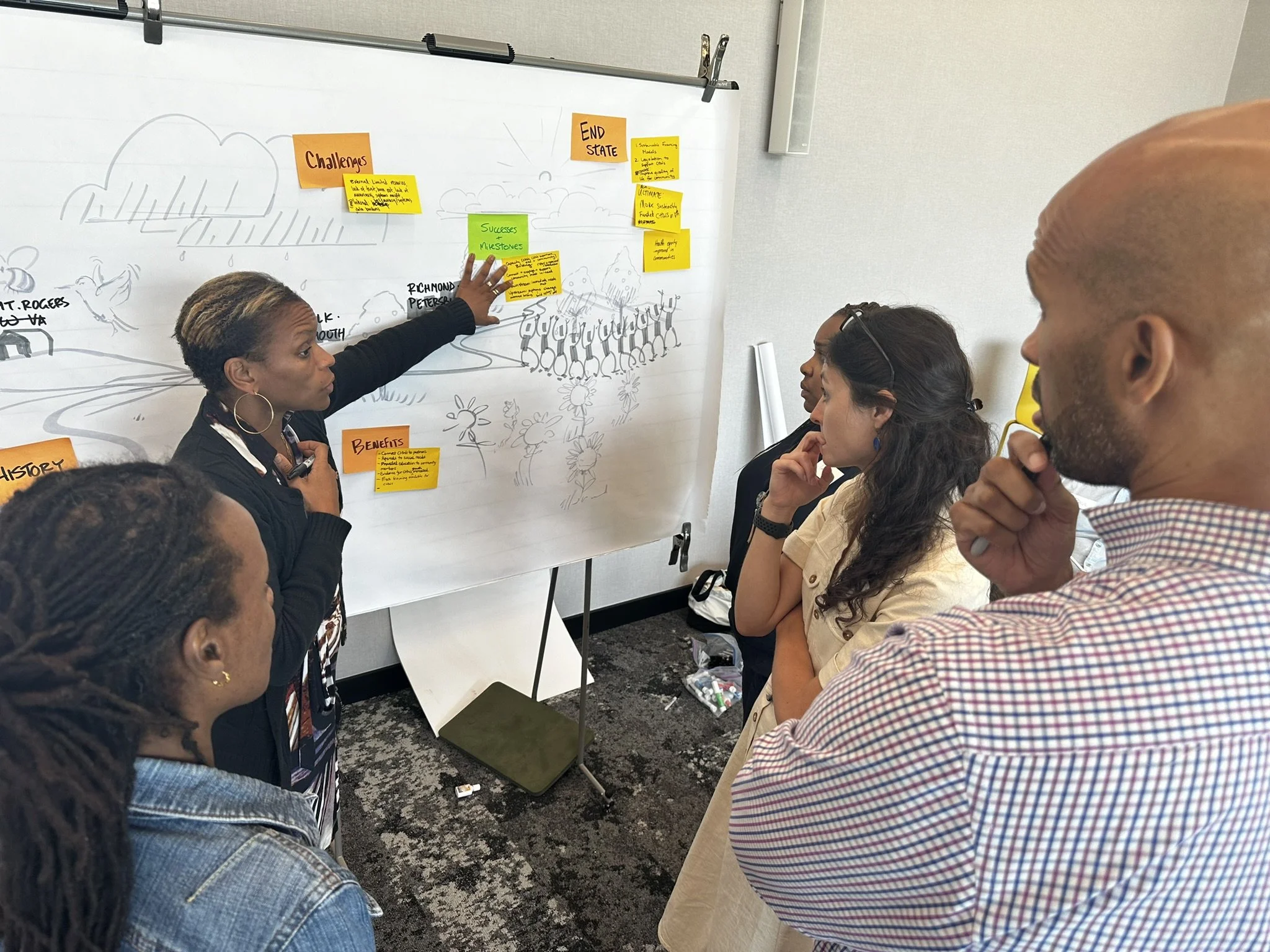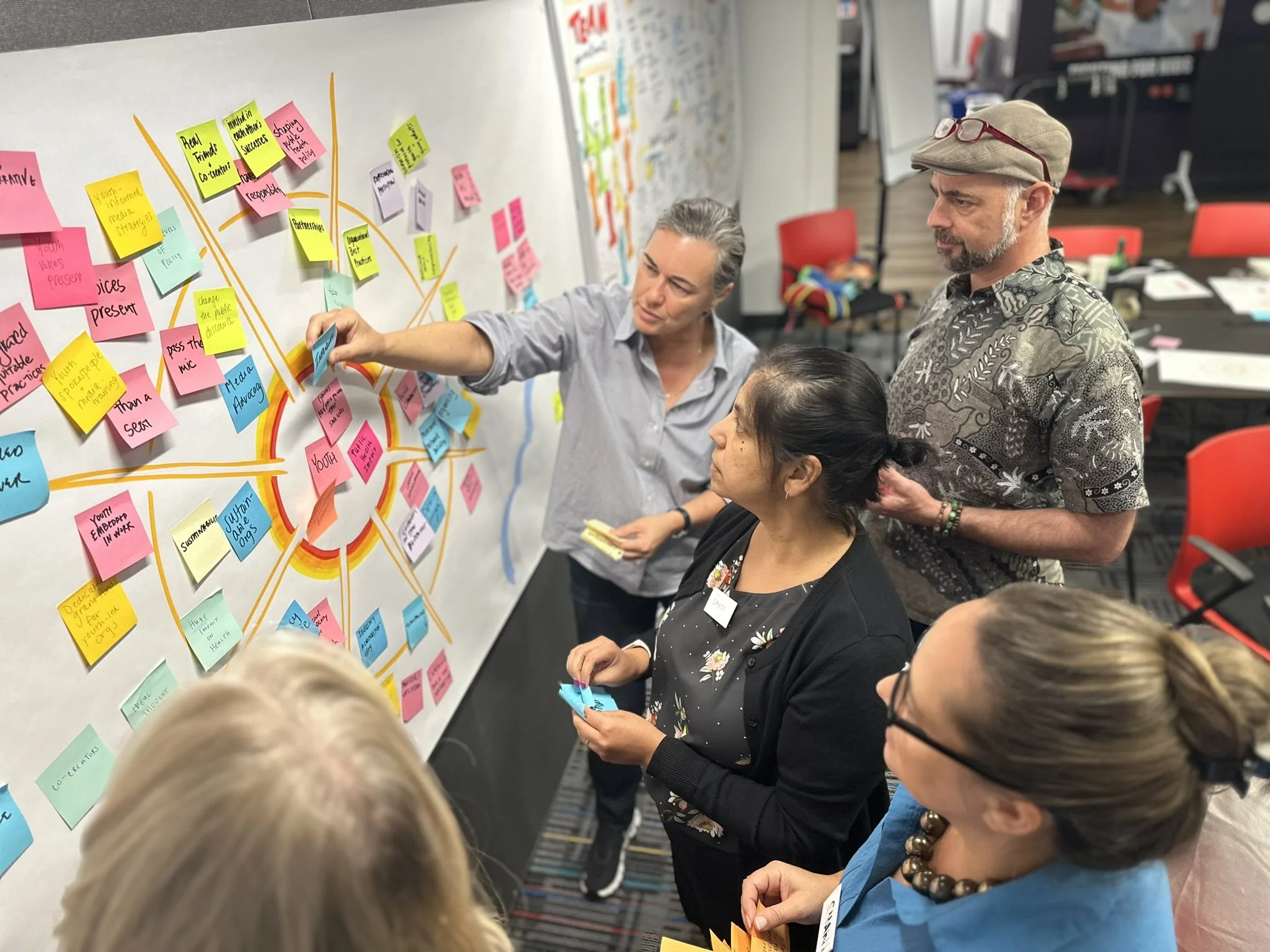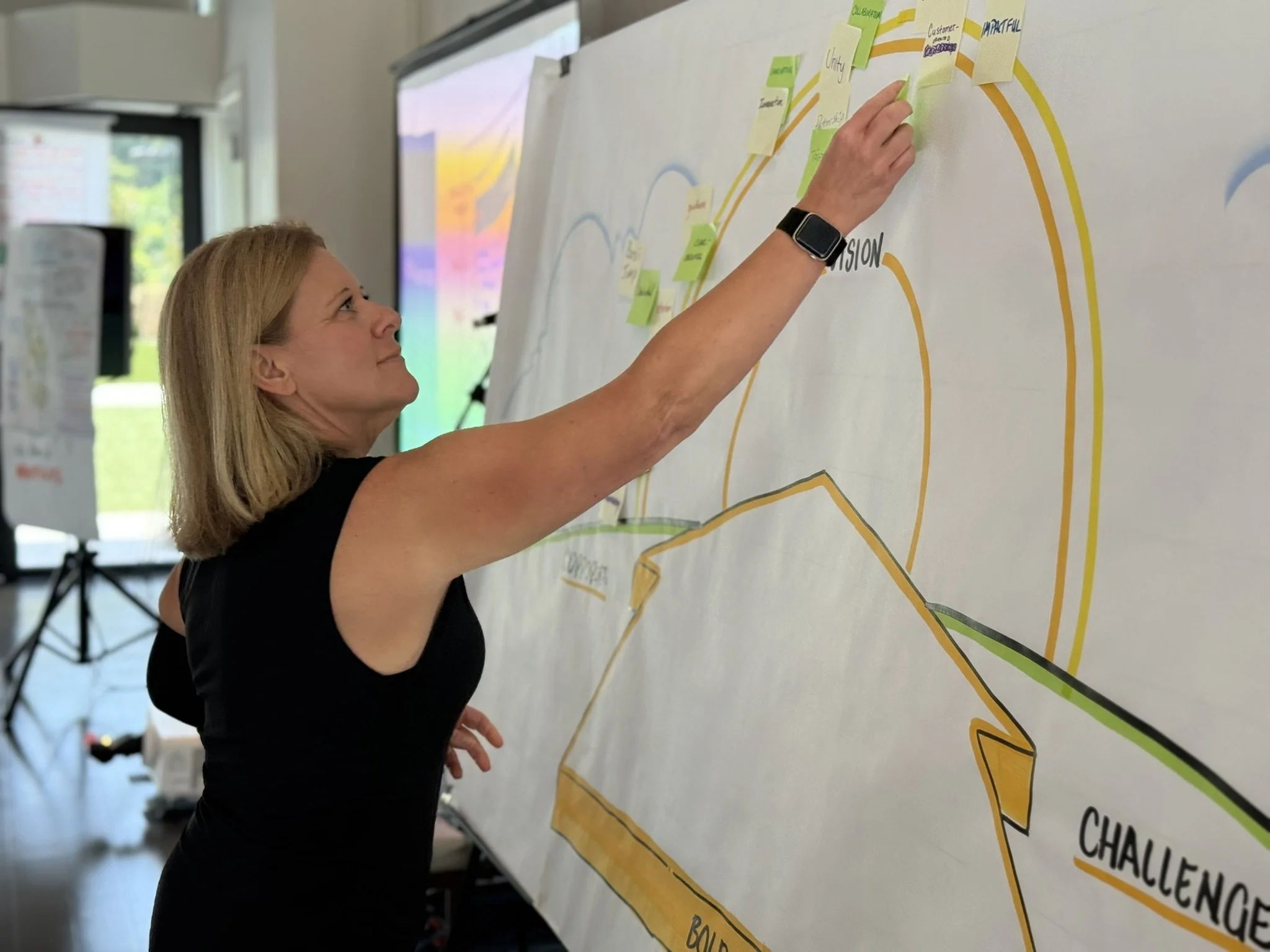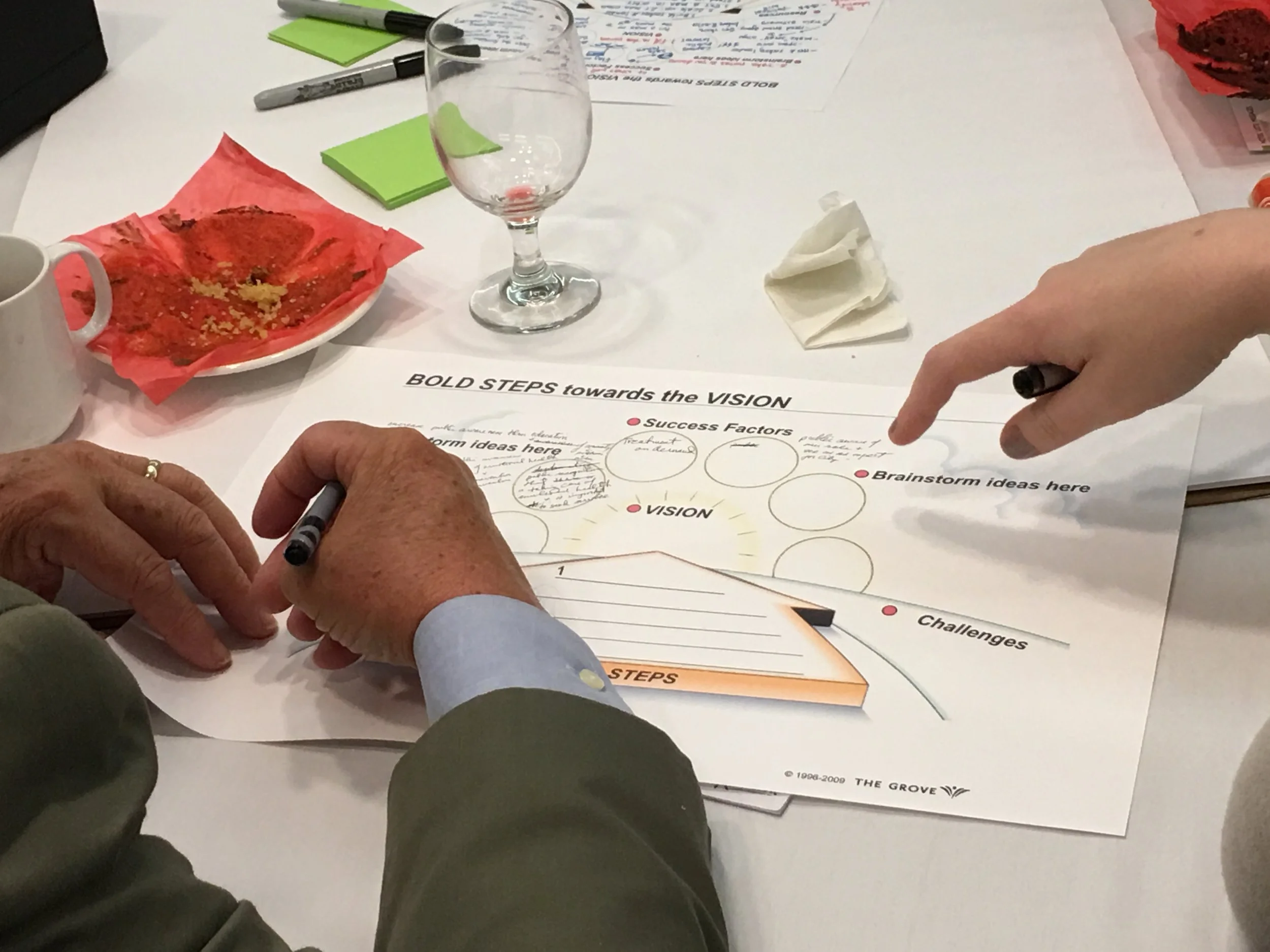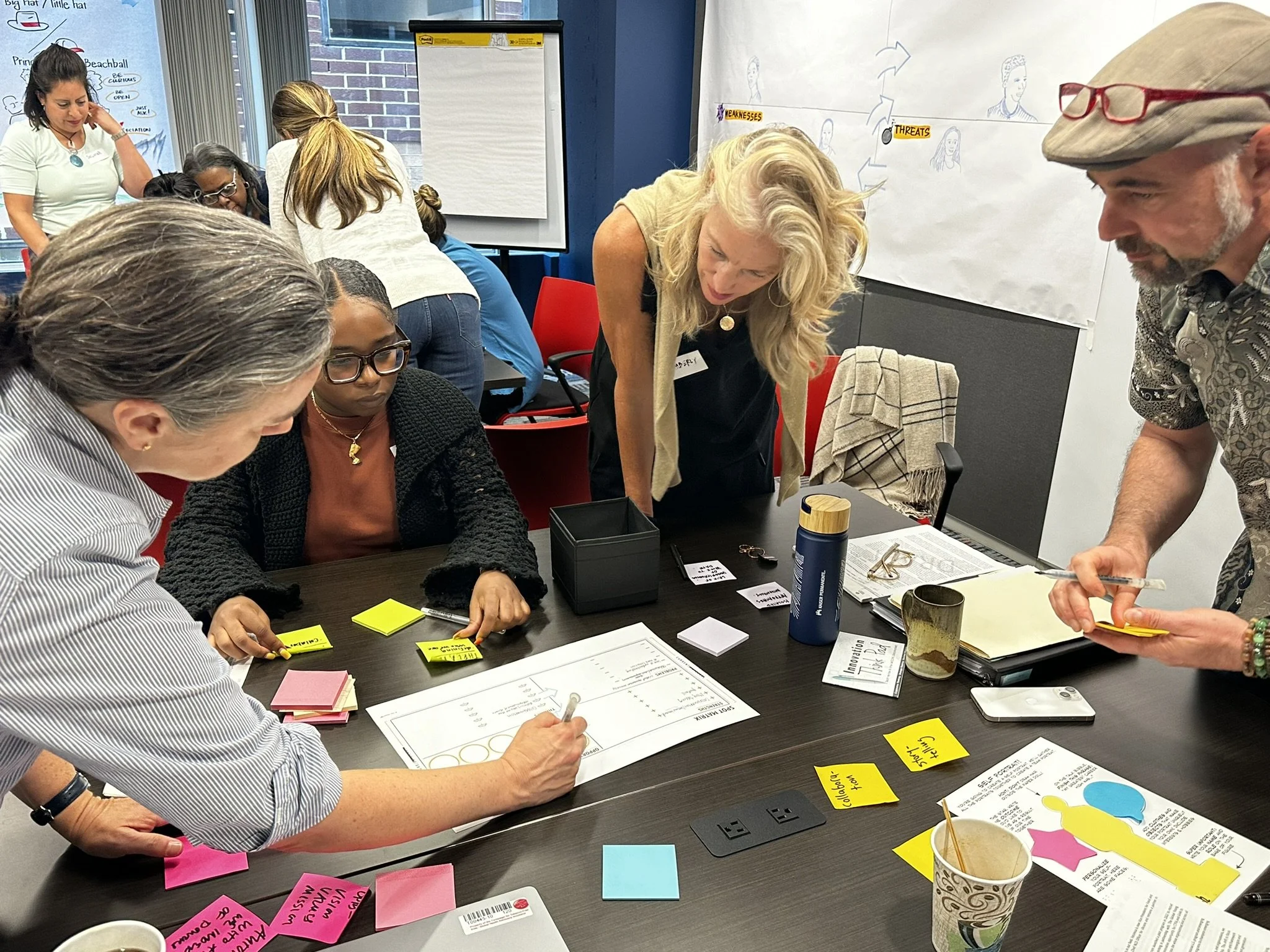The Map that Destroyed a Kingdom: The Strategy is not the Territory
A group defines their mission, vision, and purpose using visual facilitation.
Strategy work has a danger of becoming too detailed too quickly.
In his book The Management Myth, Matthew Stewart tells the story of Igor Ansoff, the Lockheed engineer who was determined to document every process down to the smallest detail. He would push a cart full of three-ring binders around Lockheed’s facilities. Ansoff may have had the answer to every question buried in his reams of three-hole-punched paper, but his teammates didn’t have the time to sift through it all to find them. And even if they had the benefit of today’s search functions, the answers they found would have been locked into the time they were written and inflexible.
The flip side is that some strategies are too high-level for employees to see themselves. I once worked for an agency that adopted a vision of putting their core function “in the user’s hand.” Even if you were to expound on that to say, “We’re building a mobile app,” which is how most employees interpreted it, it left the majority of employees in the cold, asking themselves, “How does this apply to me?”
So a strategy has to have the right level of detail: not so much to become impenetrable, not so little to be unrelatable.
A group works together to define their vision using a visual template.
A rule to make sure your strategy is at the right level of detail is to make sure it fits on a single piece of paper. Not a postage stamp, not a bumper sticker, and certainly not a three-ring binder.
And the paper can be any size. My favorite piece of paper to encapsulate an organization’s strategy is the Five Bold Steps template from the Grove’s Strategic Visioning collection of templates. When used with a group of six or more people, it’s best formatted as a large 4’x6’ wall chart that participants can use to capture their ideas. Here’s how to use it.
The Five Bold Steps are a way to visualize an organization’s strategy on a single sheet of paper.
1. Write the vision in the center of the Five Bold Steps template.
The Five Bold Steps template is available from https://grovetools-inc.com/collections/five-bold-steps
The input to the Five Bold Steps is a vision. It doesn’t have to be a perfect, crisp vision statement that’s been approved by the marketers and the lawyers. I encourage the groups I work with to settle on a word cloud of ideas that evoke what that future vision of success feels like.
Side note: A word cloud avoids the grind of wordsmithing in large groups. Refining down to a single inspired vision is a task I firmly believe should be undertaken by a VERY small group of inspired leaders and/or writers, NOT a committee who will water down and bolt on and complicate what should be a clear, concise, and memorable statement. Take input from a large group, but have a very small group decide.
2. If you’ve got a large group of more than six participants, divide them into groups of four-to-eight and give them a small Five Bold Steps template to work on. If you have a small group, skip to 3.
Tabletop-sized Five Bold Steps templates bring in the ideas of small groups.
The small templates can still be large, like 2’x3’. Don’t go smaller than 11”x17”.
Facilitator extraordinaire Casey Creech is a master of giving clear, engaging instructions that energize groups into action.
3. Instruct the use of the Five Bold Steps. Feel free to tweak these instructions for your own voice and purposes.
“Now that you have a vision of what future success might look like, you’re going to have some time to talk about how we might get there. As a group, discuss the big strategic initiatives that, if completed successfully, will mean that you will have achieved your vision. Think of your strategic initiatives as Five Bold Steps. They needn’t be sequential, or even limited to five, but I find that five is a pretty good number. Any more than that can be tough to remember, let alone resource.”
“I suggest you start by brainstorming some ideas in the clouds around the vision. Just use that space as scratch paper to capture ideas. The clouds are for ideas, not final initiatives.
“Along the way, you might find yourself saying, ‘Well, we can’t do THIS without THAT.’ And if the THAT is outside your control, congratulations! You’ve identified a Support. Think of Supports as externalities or dependencies. Just capture it. Don’t dwell on it. Write it down and move back to the initiatives.
“And along the way, you might find yourself saying, ‘Well, we can’t do THIS if THAT gets in the way.’ And if the THAT is outside your control, congratulations! You’ve identified a Challenge. Think of Challenges as obstacles, barriers, or unknowns. Just capture the Challenge. Don’t dwell on it. Write it down and move back to the initiatives.”
Side note: I like to provide a small scale version of a completed Five Bold Steps as an example of the right level of detail.
Example of a completed Five Bold Steps.
Side note: While the Grove’s Five Bold Steps has a section for Values, I usually save that for another discussion and skip that section, or go back to it later.
A group works together to complete a visual template.
4. Give guidance specific to the group you’re working with.
Depending on the temperament of the group, at this point I give special instructions to get ahead of dynamics that can stall the process.
If a group has been doing a lot of talking but not a lot of writing, I strongly encourage the use of sticky notes.
At this point in the facilitation, participants are usually already comfortable using sticky notes to brainstorm ideas and cluster ideas into common themes and categories. Give talkative teams a tangible task. The pressure to “create something” is usually enough to move a group from discussion to decision.
If a group has been focusing more on improving existing operations than adopting innovative new ideas, that may just be their culture. Drawing from the “competing values” work of Cameron and Quinn, change may show up very differently depending on culture. Culture dictates if a group prefers:
Slow, long-term development,
Breakthrough innovation,
Incremental improvements, or
Fast, short-term performance.
If a group has SAID they want to be innovative but are staying in the safety of operational improvement, I like to draw on the concept of Pioneers, Migrators, and Settlers from Blue Ocean Strategy.
Which initiatives are our Settlers: improvements tried and true things we do that pay the bills and keep the lights on?
Which initiatives are our Migrators: moving Settlers into new markets or new channels?
Which initiatives are our Pioneers: completely novel approaches and initiatives?
When you provide the Pioneer, Migrator, and Settler framework in the context of the Five Bold Steps, your participants may realize that their big initiatives are really just window dressing what they’re already doing.
Pioneer Migrator Settler map, from Blue Ocean Strategy
Wait a minute! What about that whole “map that destroyed a kingdom?” Was that just clickbait?
Nope, it sure wasn’t.
Image created by ChatGPT.
If a group has been diving into the weeds of details and including too much information to be useful to communicate the strategy, tell this story.
“In a kingdom long ago, there lived a king who ruled as far as he could see. Marveling at his own magnificence, he told his advisors to draw a map of his kingdom, so that he might know the extent of his power. His advisors complied and drew a beautiful map, and laid it at the foot of the king’s throne. But the king shook his head. ‘From my window, I can see a farm on the hillside. Where is the farm on the map? Do I not hold domain over all I see?’ So the advisors took away the map and drew another, larger, more detailed map. But again the king shook his head. ‘From my window I see a tree. Where is the tree on the map? Do I not hold domain over all I see?’ So again the advisors drew another larger more detailed map.
“You can see where this is going. Eventually, the map grew so large that it covered the kingdom.
“The map is not the territory. If we had a map that was at a ‘perfect’ scale, one mile on the map would equal one mile in reality. And that map would be entirely useless. A map is a representation of the strategy. It won’t tell you every task every employee will do.”
Side note: this is a retelling of the short story “Del rigor en la ciencia” by Jorge Luis Borges.
At this point, I reference the principle of Altitude from the initial meeting kick off.
Principle: Be at the right Altitude
And if, after all this, the group still struggles with going too deep into the weeds of detail, I remind them that whatever they do has to fit on a single sheet of paper.
Need help with strategic planning facilitation? Contact Lizard Brain today.

